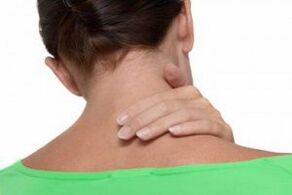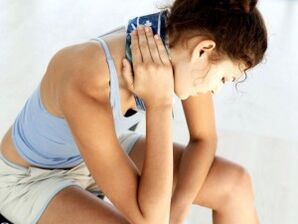Cervical osteochondrosis is common, accompanied by pain in the head, neck, shoulder girdle, brain circulation is impaired. The peculiarity of the localization of the pathological process and the opposite manifestations force the patient to turn to a specialist for help. Lack of timely treatment threatens disability.
Often, cervical osteochondrosis affects young people (up to 40 years old), contributing to the development of incorrect body position (sitting for a long time in front of the computer, the habit of holding the phone with your shoulder), vibration, poor posture, physical inactivity, beduncomfortable, hereditary.
Possible reasons
This disease is accompanied by degenerative-dystrophic changes that affect the intervertebral discs of the cervical spine. This is caused by metabolic disorders in the cervical area, as a result of which the structure of the intervertebral discs and their bodies change.
The main cause of the disease:
- high salt levels in lymph and blood (in active people there is a constant exchange between bones and muscle tissue, with a static lifestyle, blood flow slows down, less salt enters muscle tissue, they accumulate in places that do not work physically - joints, bonesback, kidney, liver);
- an irreversible phenomenon that occurs in the cartilage tissue (salt deposition causes changes in the shock-absorbing properties of the vertebrae, the flexibility and elasticity of the cartilage tissue is lost);
- staying for a long time in a position that causes overstrain of the muscles of the neck, back (working at a desk with a twisted neck and tilted head), squeezing the vessels that supply the spine occurs, which leads to the degeneration of intervertebral cartilage;
- with obesity, the spine and intervertebral discs undergo deformation due to high loads, the back muscle corset weakens;
- due to improper metabolism, the balance of minerals in bone tissue is disturbed.
Characteristic symptoms

The main manifestations of cervical osteochondrosis:
- pain in the back of the head, neck, shoulders, arms, difficulty moving the head, throbbing when turning the head or tilting;
- pulling pain in the chest area on the left side with radiation to the left hand, burning sensation in the interscapular area;
- recurrent headaches, fatigue, weakness, difficulty turning the head;
- pain in the neck passing through the shoulders and arms, numbness of the fingers;
- there may be deterioration in hearing and vision, numbness of the tongue and face, dizziness, impaired activity of the lungs and heart.
Conventionally, symptoms are divided into groups:
- I - neurological manifestations (constant pain in the neck, pain in the muscles, chest, joints);
- II - pathological effects on the spinal cord (weakness in the arms and legs, involuntary twitching, myelopathy);
- III - associated with processes occurring in the brain (cerebral manifestations due to insufficient blood supply: visual disturbances, feeling of a foreign body in the throat, noise and ringing in the ears, hearing loss, dizziness, unsteadiness when walking, fainting, fatigue, irritability, sleep disturbances, memory loss).
General recommendations
If there are no indications for hospitalization, outpatient treatment is prescribed (most of the time the patient is at home, visiting a neurologist on the specified days). Of the drugs used:
- NSAID course 7 - 14 days (daily 2 - 3 times);
- sedatives protect the nervous system from the influence of pain, a course of 1 - 3 weeks;
- diuretics to reduce swelling in inflamed areas;
- Vitamin B to improve metabolic processes occurring in nervous tissue, normalize musculoskeletal circulation;
- muscle relaxants to relieve muscle spasms;
- means improving the structure and function of cartilage tissue (ATP, chondroprotectors);
- topical - cream, gel, ointment as warming, analgesic or distraction.
With increasing pain, bed rest is recommended, a physiological position (to relieve the load from the spine) for 1-2 days, after which the patient should start moving.
In the acute stage, it is necessary to do breathing exercises and exercises to relieve muscle spasms (head tilting and turning, circular movements), gradually increasing the load. You should not make sudden movements.
With muscle spasms, massage is prescribed (you can massage yourself on the neck). For preventive purposes, massage courses should be conducted twice a year. To unload the spine, a cervical collar or a Glisson loop is used (after prior consultation with the doctor).
Nutrition should be adjusted by excluding foods that increase muscle tone (smoke and spicy, alcohol, coffee, tea). For cartilage tissue is useful:

- foods high in calcium (fermented milk, cottage cheese, mineral water, dark green leafy vegetables);
- unsaturated fatty acids (fatty fish, flaxseeds, nuts);
- protein (lean chicken, dairy products, eggs, nuts);
- foods high in fiber and antioxidants (legumes, grains, fruits).
If there is no aggravation, it is recommended to drink enough water (30 ml per 1 kg of body weight), strengthen the spine and back muscles through physical exercise. When working for a long time sitting, you need to rest every hour, relax the back muscles with the help of exercises.
How to treat folk remedies?
With cervical osteochondrosis, it is recommended to take herbal infusions or decoctions, rub the ointment on the problem area.
| Components | Quantity | Application mode |
|---|---|---|
| pine needles | 250 g | Brew the needle with a liter of boiling water, insist. Drink twice a day. |
| Garlic, ginger | 1: 1 | For grated ginger add garlic, a little butter. Rub on the sore neck. |
| Lemon, garlic | 4 things. and 5 pcs. | Pass lemon and garlic through a meat grinder, pour 2 liters of boiling water. Drink ½ cup twice a day. |
| Fresh potatoes, honey | 1: 1 | Mix gruel from grated potatoes with honey, apply on the neck. |
| radish leaves | 1 pc. | Dip the radish leaves in boiling water for a few seconds and remove. Cool the liquid, use it to compress. |
| horseradish root | 2 teaspoons | Grated carrot root is placed on the bandage, attach it to the neck, cover with plastic wrap on top and wrap. Hold for 1 - 1. 5 minutes, then rinse with water. |
| Love | 1 dessert spoon | Pre-heat the neck, do a self-massage with honey for 5 minutes. After that, wrap your neck. |
What is not recommended?
With cervical osteochondrosis, you can not:
- lift weights (if necessary, perform actions with a straight back, without tilting the head forward);
- you can not crush the vertebrae (this movement violates the integrity of the contact surface of the spine);
- sleeping on high pillows, soft beds (causes tension in the back muscles);
- lead an inactive lifestyle (jogging, swimming, walking are useful);
- independently diagnose and prescribe treatment.
Preventive measures

To prevent cervical osteochondrosis, it is recommended:
- get rid of hypodynamia (move more, engage in Nordic walking, dancing, swimming);
- monitor body weight, avoid excess weight (it leads to impaired blood circulation, nutrition of the collar zone);
- monitor posture (if it is violated, the load on the spine is unevenly distributed);
- avoid microtrauma in the cervical area (lift heavy and wear correctly);
- treat the focus of chronic infections (ENT organs, etc. ), which reduce the body's resistance, lymph and blood circulation in the ligaments and tissues of the neck.
Good results in the treatment of cervical osteochondrosis can be obtained using complex treatment. Home treatment will be effective only with careful adherence to all prescriptions and its daily use.



















